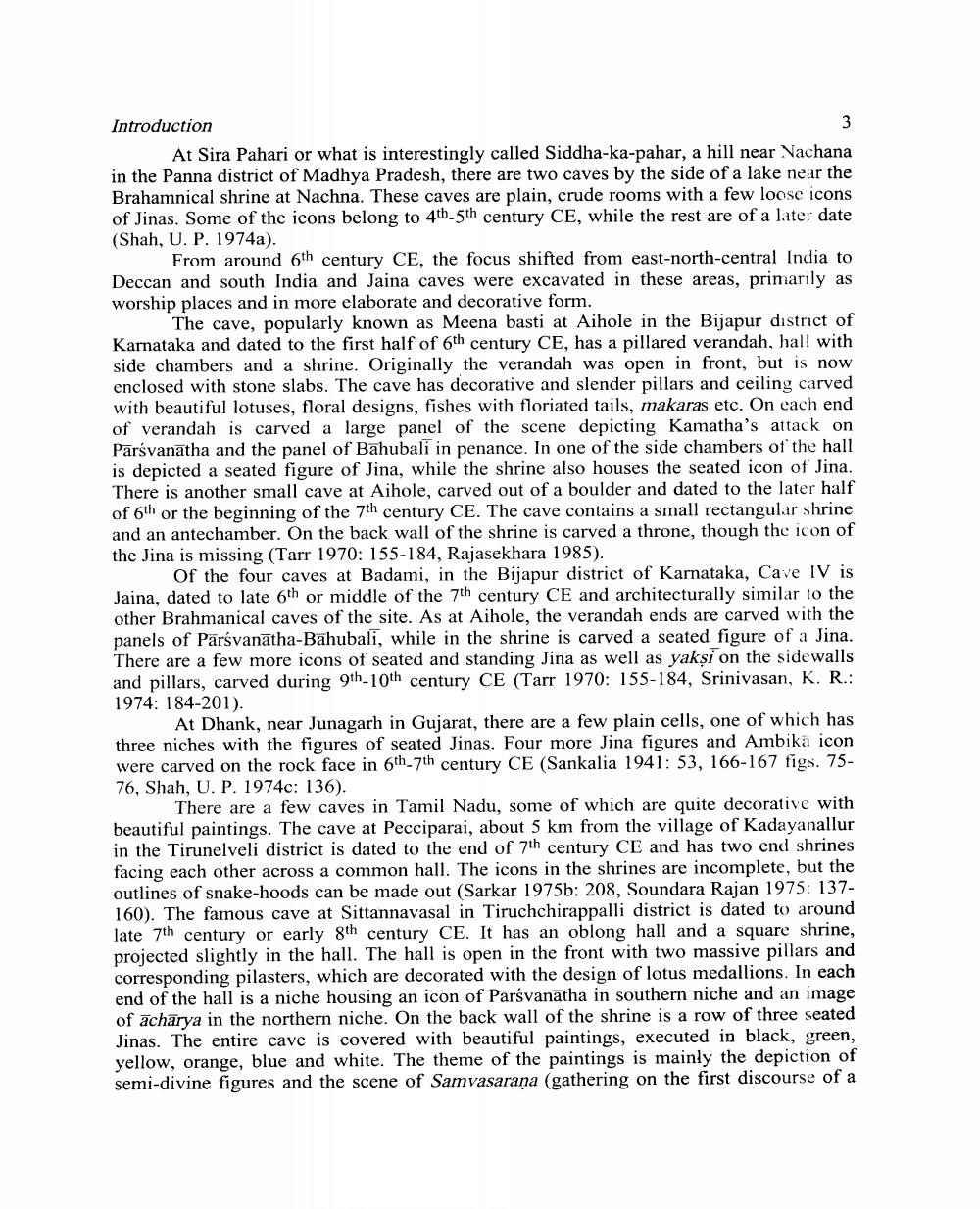________________
Introduction
At Sira Pahari or what is interestingly called Siddha-ka-pahar, a hill near Nachana in the Panna district of Madhya Pradesh, there are two caves by the side of a lake near the Brahamnical shrine at Nachna. These caves are plain, crude rooms with a few loose icons of Jinas. Some of the icons belong to 4th-5th century CE, while the rest are of a later date (Shah, U. P. 1974a).
From around 6th century CE, the focus shifted from east-north-central India to Deccan and south India and Jaina caves were excavated in these areas, primarily as worship places and in more elaborate and decorative form.
The cave, popularly known as Meena basti at Aihole in the Bijapur district of Karnataka and dated to the first half of 6th century CE, has a pillared verandah, hall with side chambers and a shrine. Originally the verandah was open in front, but is now enclosed with stone slabs. The cave has decorative and slender pillars and ceiling carved with beautiful lotuses, floral designs, fishes with floriated tails, makaras etc. On each end of verandah is carved a large panel of the scene depicting Kamatha's attack on Parsvanatha and the panel of Bahubali in penance. In one of the side chambers of the hall is depicted a seated figure of Jina, while the shrine also houses the seated icon of Jina. There is another small cave at Aihole, carved out of a boulder and dated to the later half of 6th or the beginning of the 7th century CE. The cave contains a small rectangular shrine and an antechamber. On the back wall of the shrine is carved a throne, though the icon of the Jina is missing (Tarr 1970: 155-184, Rajasekhara 1985).
Of the four caves at Badami, in the Bijapur district of Karnataka, Cave IV is Jaina, dated to late 6th or middle of the 7th century CE and architecturally similar to the other Brahmanical caves of the site. As at Aihole, the verandah ends are carved with the panels of Parsvanatha-Bahubali, while in the shrine is carved a seated figure of a Jina. There are a few more icons of seated and standing Jina as well as yaksi on the sidewalls and pillars, carved during 9th-10th century CE (Tarr 1970: 155-184, Srinivasan, K. R.: 1974: 184-201).
At Dhank, near Junagarh in Gujarat, there are a few plain cells, one of which has three niches with the figures of seated Jinas. Four more Jina figures and Ambika icon were carved on the rock face in 6th-7th century CE (Sankalia 1941: 53, 166-167 figs. 7576, Shah, U. P. 1974c: 136).
There are a few caves in Tamil Nadu, some of which are quite decorative with beautiful paintings. The cave at Pecciparai, about 5 km from the village of Kadayanallur in the Tirunelveli district is dated to the end of 7th century CE and has two end shrines facing each other across a common hall. The icons in the shrines are incomplete, but the outlines of snake-hoods can be made out (Sarkar 1975b: 208, Soundara Rajan 1975: 137160). The famous cave at Sittannavasal in Tiruchchirappalli district is dated to around late 7th century or early 8th century CE. It has an oblong hall and a square shrine, projected slightly in the hall. The hall is open in the front with two massive pillars and corresponding pilasters, which are decorated with the design of lotus medallions. In each end of the hall is a niche housing an icon of Parsvanatha in southern niche and an image of acharya in the northern niche. On the back wall of the shrine is a row of three seated Jinas. The entire cave is covered with beautiful paintings, executed in black, green, yellow, orange, blue and white. The theme of the paintings is mainly the depiction of semi-divine figures and the scene of Samvasaraņa (gathering on the first discourse of a




